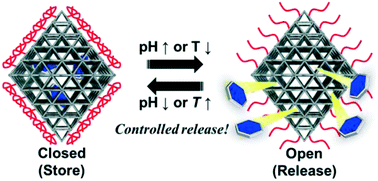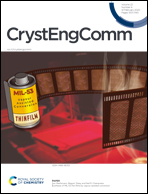Metal–organic framework tethering pH- and thermo-responsive polymer for ON–OFF controlled release of guest molecules†
Abstract
The controlled release of small molecules from carrier materials by manipulating the environmental conditions has potential for use in drug delivery. In the present study, we demonstrate the controlled release of a guest molecule (procainamide) from a metal–organic framework (MOF). The MOF is covered with a copolymer of N-isopropyl acrylamide (NIPAM) and acrylic acid (AA) by post-synthetic modification. The polymer exhibits a rapid and reversible coil–globule transition that is both pH- and thermoresponsive, thereby allowing the guest molecules to be released from the MOF in an “on–off” manner. At high pH (6.86) or low temperatures (<25 °C)—when the polymer adopts a coil conformation—the guest molecules are rapidly released from the MOF, whereas at low pH (4.01) or high temperatures (>40 °C)—when the polymer adopts a globule conformation—the release of the guest molecules is suppressed. The release can be halted by applying external stimuli even after starting the release. The MOF-derived controllable container introduced here will facilitate targeted drug delivery and controlled release of therapeutic agents.



 Please wait while we load your content...
Please wait while we load your content...